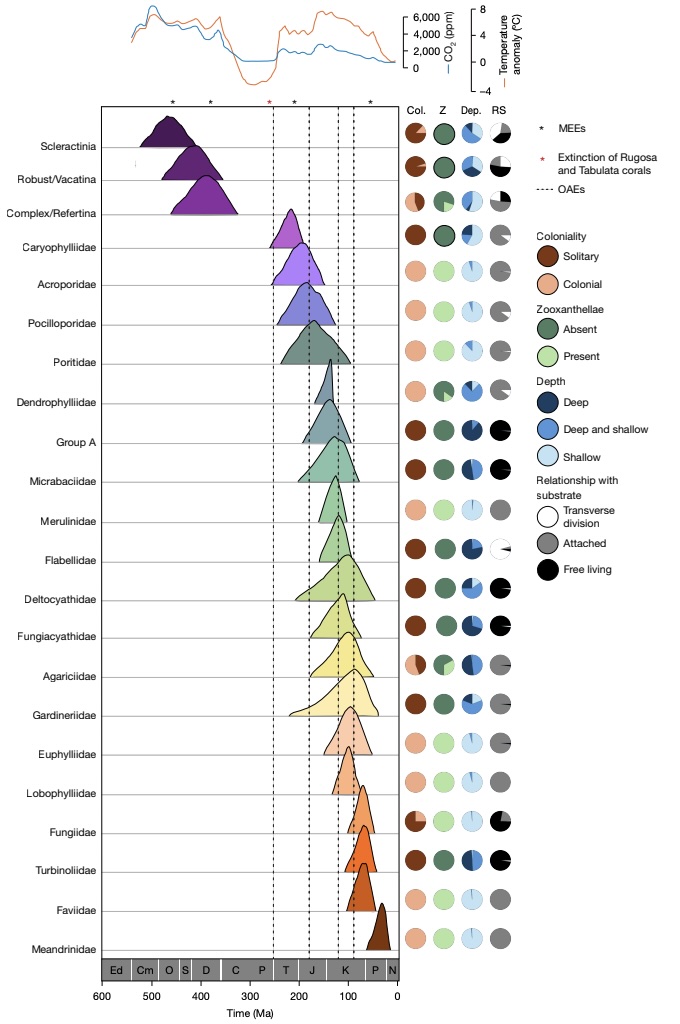This pathbreaking paper reveals the entire evolutionary history of the corals, based on pioneering studies of coral DNA.
Coral taxonomy, traditionally based on morphology since Ellis and Solander (1786), has long been confounded by extensive divergence of corals that are closely related, and convergence of those that aren’t.
The earliest coral researchers realized morphology was a poor guide to taxonomy, but as classification was based on fossils, they had no choice.
Coral scientists have therefore long awaited a comprehensive analysis of coral DNA so classificatory relationships can be based on shared genetics and ancestry, not misleading morphological similarities and differences.
The results are fascinating: for some groups traditional classification is strongly supported, for others it is overturned, previously lumped taxa are now split, previously separate taxa are now grouped together, and 14 entirely new evolutionary branches are now revealed as distinct.
The modern Scleractinian corals are one of several major coral groups that evolved and grew wave-resistant and bio-diverse coral reef ecosystems around 450 million years, but the other major groups, the Tabulate corals and the Rugose corals, vanished in the Permo-Triassic Extinctions.
Whenever disastrous mass extinctions or global ocean anoxic events occurred, and shallow coral reefs disappeared, small isolated deep-sea Scleractinian corals in marginal habitats evolved into new colonial symbiotic species that regrew large shallow coral reefs again within several million years.
The secret to coral resilience revealed by their phylogenetic history is that most Scleractinian corals are small, solitary, and live in the deep sea, but they have repearedly evolved both complex colonial morphologies and algae symbiosis essential to make large tropical coral reefs.
The coral history revealed by this paper suggests optimistically that the ongoing mass extinction of coral reef ecosystems caused by fossil fuel addiction, which is already mostly over, will eventually result in evolution of new coral reefs several million years after collapse of the fossil fuel economy that caused global warming, giving optimism for eventual future recovery of coral reef ecosystems on geological time scales, but not on human ones!
The authors of this paper include the world’s top coral taxonomists, especially those who focus on the smaller, isolated non-reef building species, the core from which modern reef-building corals have repeatedly evolved, the major cause of the massive morphological convergences that confused earlier generations of taxonomists.
They point out that many more species remain to be sequenced, especially in the most rapidly evolving genera with the greatest range of shapes.
This pathbreaking and definitive work of Natural History was not supported by any of the rich country science funding agencies, it was funded in major part by the Fundaçao do Estado do São Paulo, thanks to efforts of Brazilian coral researchers. All coral Natural Historians are forever indebted to them for resolving the relationships Ellis and Solander could only guess at.
Muito obrigado!
 Coral history, from Vaga CF, Quattrini AM, Galvão de Lossio e Seiblitz I, Huang D, Quek ZB, Stolarski J, Cairns SD, Kitahara MV. A global coral phylogeny reveals resilience and vulnerability through deep time. Nature. 2025 22:1-6.
Coral history, from Vaga CF, Quattrini AM, Galvão de Lossio e Seiblitz I, Huang D, Quek ZB, Stolarski J, Cairns SD, Kitahara MV. A global coral phylogeny reveals resilience and vulnerability through deep time. Nature. 2025 22:1-6.


